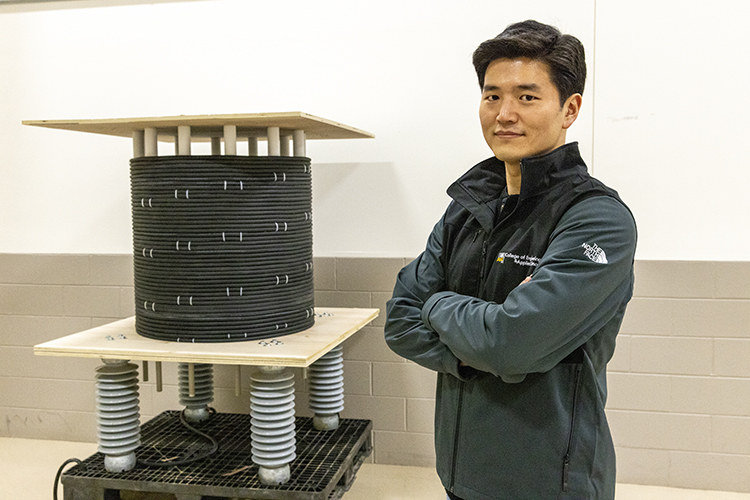
Chanyeop Park shows the inductor in his lab. It’s part of a research project he and Georgia Tech are working on to create a high-voltage circuit breaker that uses a much greener alternative to the gas currently used in high voltage electrical equipment. (UWM Photo/Troye Fox)
The world’s most potent greenhouse gas – and one that most people have never heard of – is becoming a worrisome contributor to global warming because of an increasing demand for electricity and aging energy infrastructure.
The gas, called sulfur hexafluoride (SF6), for decades has been used in high-voltage electrical distribution equipment as an insulator. But leakage into the atmosphere, which has always occurred, is accelerating as the infrastructure ages.
Chanyeop Park, UWM assistant professor of electrical engineering, is working with researchers at Georgia Institute of Technology on a nearly $4 million grant from the U.S. Department of Energy to develop and test an environmentally neutral alternative. A quarter of the grant funds Park’s role.
“The global warming potential of SF6 is roughly 24,000 times higher than that of carbon dioxide (CO2), and it is very stable,” he said. “Once it goes into the atmosphere, it stays there for literally thousands of years.”
Here Park spells out some details about this research.
First, explain what high voltage circuit breakers do. Why is the gas needed in them?
Electrical substations contain a high voltage system that delivers electricity to our homes. Those substations include circuit breakers, which we call switchgear, that uses SF6 gas as an insulator.
Circuit breakers protect the power grid by interrupting electrical current when needed, so that electric circuits and devices are not overloaded. With SF6 we’re talking about circuit breakers on a really large transmission level. The circuit breakers in your home don’t contain SF6 because they are low voltage and air can do the insulating.
Usually, SF6 is contained inside a metal chamber or bottle. But nothing is 100% leak free. Trace amounts leak out over time, in the same way that tire pressure decreases because of air leaking at a very slow rate.
Tell us about the alternative to SF6 that you are testing.
It’s called supercritical CO2 and it’s something that we can achieve by increasing the pressure and temperature of CO2. Its unique characteristic is it behaves like both a liquid and a gas simultaneously.
Liquids are very dense compared to gas. That’s why you have a hard time swimming because liquid is so dense, right? The high density provides strong electrical insulation. But supercritical fluid also behaves like gas, which is low in viscosity. So supercritical fluids, with both of those benefits combined, are very effective for cooling and insulating. The substance provides protection by taking heat away from one side of equipment and dropping it on the other side. And its fluid behavior provides the capability of quick movement.
Also, because supercritical fluid is made of pure CO2, theoretically it is 24,000 times friendlier to the environment than SF6.
Why is now the right time to transition to a new insulator for this essential equipment?
Most power plants are located at or near sea water or some kind of body of water which can help cool the plant. The power then has to be transmitted from the plant and distributed to where people live. As we acquire and integrate more green sources into our energy mix, those sources can be places relatively close to where we live.
So, as the infrastructure changes and we upgrade the aging grid, we can reconfigure it to use supercritical CO2. You’re still going to need an insulator for a rising amount of switchgear.
And, if all existing SF6 switchgear is replaced with our technology, it would have an enormous positive impact on the environment.
How would you make the supercritical fluid that that you’re proposing? And what is your role in the project?
All that’s needed is liquefied CO2. Once you put it into the switchgear, it will heat up and turn into a supercritical CO2 at some point. We can actively control the temperature and pressure.
As a PhD student, I developed computational modeling of gas discharge behavior. Now I’m using that technique to model electrical discharge behavior in CO2 supercritical fluid. The other thing I’m doing is developing a testbed, called the synthetic circuit, to assess the switchgear’s performance once they’re reinvented with the new insulator and design.
What is the next step when the funding ends in 2025?
The goal of the project is to bring the technology to market. There is no other commercially available alternative to SF6 that is as environmentally friendly as supercritical CO2. So, this project is a high-risk, high-reward type of research. If it succeeds, we will start a business or license our technology.
Written by Laura Otto
Link to original story: https://uwm.edu/news/uwm-researcher-works-on-replacing-the-most-potent-greenhouse-gas-of-all/
